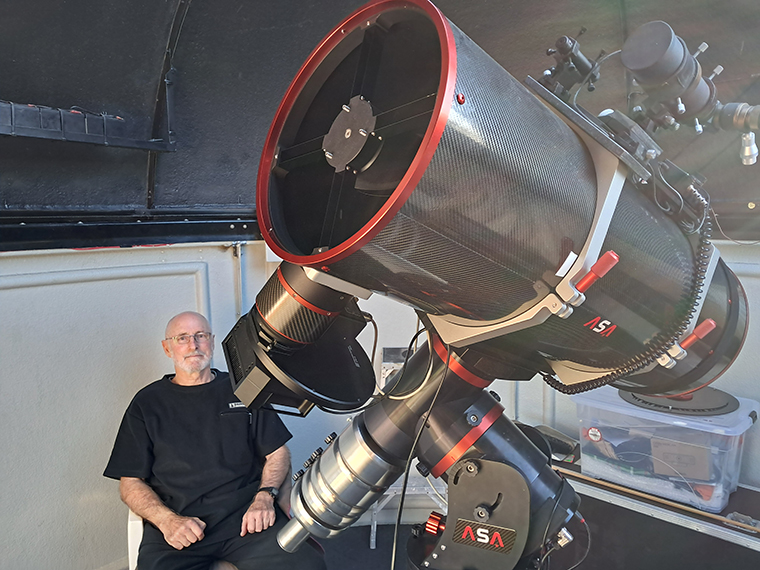A dark “dry site with good seeing” inside a dark sky reserve were the key conditions for astronomy enthusiast John Whitby to set up his Star Field facility which has sprouted six observatories on his land south of Martinborough – with another on the drawing board.
“I had five years searching for a dark sky property in New Zealand,” which included a block in the Coromandel Forest Park – “but it rained (there) every other day,” he told The Star. “Cloud would come and go every other hour and you would never get eight hours of straight, clear weather.”
His search centred on Martinborough and Golden Bay – the latter “because of the extreme darkness of the site. It’s one of the darkest sites in New Zealand.”
Why Martinborough? “Because it was a dry sight and there was good seeing. A dark site and the area became a dark sky reserve (with lighting control regulations to keep it dark).”
It was difficult for amateur astronomers to find a dark place to take their equipment – or even visit to look through big telescopes.
So Whitby set up a 10-acre area which attracted all the “star people,” and led to a decision to “set up (an) amenity” for viewing the stars.
A private observatory came in first, followed by Wellington Astronomical Society, “and they built a remote (controlled) observatory here for $200,000” from a private bequest. That came after Whitby had built two observatories for his own purposes; then he built a third.
They comprise two domes with imaging telescopes and a third with a roll-off roof for “visual viewing,” named for Wairarapa Astronomical Society president Darryl Ramsay.
Two other private observatories are also operating, one remotely controlled by its Wellington owner.
“All the local astronomers ended up coming here because I had a dark site.”
Then people asked to locate observatories at Star Field, including Wellington Astronomical Society.
The result is a total of six observatories, including three “robotic” observatories controlled from outside the Wairarapa by internet connection powered by solar systems.
Most observatory telescopes at the Star Field complex are currently for Astrophotography projects but science projects are anticipated in the near future for several of the observatories.
Imaging observatories are used for “deep space exploration and photographing those objects,” using various filters and luminants to colour the object, he explains.
Using the “Hubble palette” range of tints usually produces what he terms “strange colours … whereas 90 percent of my images are true colour.”
While most astrophotographers spend “six or seven hours on an image, I will spend upwards to 200 hours on an image – which in some cases can take up to two years to collect the data” required.

Initial data is collected by cameras on the telescope, “pointing at the sky and following it through the sky by remote control that’s all computerised.
“That produces raw data – anything from 20 seconds up to three minutes, five, 10, even up to 20 minute exposures – depending on what you are trying to achieve.”
Each exposure is basically the lens fully open for the length of time. So a 20 minutes exposure is the lens peering into the dark at that object for the whole time. “So everything has got to be very precise – and that’s why it’s so expensive,” he laughs.
The data is downloaded, correlated and organised into files and folders for processing.
“That is where you stack all the images together and do various processes to change the colours, change the view and change the intensity of the varying filters that you’ve used.”
One “quick image” can be produced in one night, but “to process it to where you get intricate detail you need to spend probably a couple of weeks – two to three hours a day – just processing that image.”
It will be the “final image you produce from all that data – always of a deep sky object. That’s usually a galaxy, a nebula, a nebulosity – which is dust and gas basically – either reflecting or emitting colours.
“A typical thing you might image would be a star that’s exploded and created a nebula of dust and gas that has blown off into space.” The “colours” represent different types of gas, with Hydrogen Alpha in red, Oxygen 3 in blue/green and Hydrogen Beta which is blue/green “so now we have red, green and blue, the basic colours of imaging.”
“It’s a bit of an art form and it uses quite complicated processing programmes.”
People producing such images post them online and to web sites for others to view.
“I don’t post them – I only show them to people interested when they come here” to Star Field.
“The satisfaction comes from producing them,” he added. “Creating the image is the really satisfying part.
“You start off staring at a piece of sky where you can hardly see anything at all, even with a high-powered telescope there’s hardly anything there.
“After 200 hours you start seeing things you can’t normally see – and you start seeing what the Hubble Space Telescope sees – but you see it yourself and … are actually producing it.”
“It is really satisfying to track something in the sky over many months and then produce a deep, detailed image of that object.
“It’s also a challenge … because everything has got to run like clockwork and there’s quite a lot of software involved, which is quite complex.” Then there are hundreds of pages of processing and post-processing techniques – “which are changing every week.”

“Star parties” see astronomy enthusiasts, many with telescopes, visit Star Field once or twice a
month, using its clear, dark sky for “visual viewing or imaging” observations from tripod or observatory-mounted telescopes.
Star Field also opens the Darryl Ramsay Observatory so visitors can uses its 12 and 18-inch telescopes.
“It’s all to do with looking at stars through high-powered telescopes” for two to three hours, “then people freeze and they want to go home.”
“Planets, star clusters, globular clusters, nebulae, planetary nebulae … and whatever is out there we can show them – unless it’s too far away, then we can’t show them. That’s when imaging comes in.”
Objects which Whitby images are “thousands of light years away … but I don’t remember numbers like that – it’s just a long way away.”
“I often see the most spectacular scenes of the night sky – usually about 2:00 o’clock in the morning, when it’s the darkest”.
“The Milky Way directly overhead on a very clear night and good seeing is an absolutely awe-inspiring sight. I always look at it and say to myself: ‘we’re never going to get off this galaxy – it’s just too big. It’s too wide.
“We can’t even get to the nearest star which is only four light years away.
“We have a galaxy which is 100,000 light years across. There’s no way in hell we’re going to get across that. The closest we can get is the Moon. The human race will be a passing blip in time.”
(Light year: the distance light travels in one year, which is 9.4607 × 1012 km – nearly 6 million million miles).



